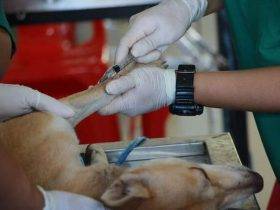Brown spots on a dog belly refer to areas of pigmentation or discoloration that appear as dark brown dog patches or spots on the skin. These spots can vary in size and may be more noticeable in dogs with lighter or thin fur. While brown spots on a dog’s belly can be harmless and simply a natural variation in pigmentation, they can also indicate an underlying health issue or skin condition that requires attention.
it is important to be aware of the potential underlying reasons for these spots and how to address them. By understanding the factors contributing to brown spots on your dog’s belly, you can ensure their optimal health and well-being.
What Causes Brown Spots on a Dog’s Belly?
Brown spots on a dog belly can stem from various causes, such as allergies, fungal or bacterial infections, hormonal imbalances, and even excessive grooming or licking. brown spots on puppy belly can be common if not well taking care off It is essential to identify the root cause to provide appropriate treatment.
Hyperpigmentation
Some dogs naturally have more pigmentation in certain areas, including their bellies. This is usually a harmless condition and does not require treatment.
Allergies
Allergies, whether caused by environmental factors, food, or fleas, can lead to skin inflammation and irritation. Excessive scratching, licking, and chewing can result in brown spots on the belly.
Infections
Fungal or bacterial infections can cause skin discoloration and brown spots. Conditions such as ringworm or pyoderma (bacterial skin infection) may manifest as dark patches on the belly.
Hormonal imbalances
Hormonal disorders like Cushing’s disease or hypothyroidism can affect the pigmentation of a dog’s skin, leading to the development of brown spots.
Trauma or injury
Previous wounds, scars, or trauma to the belly area can cause changes in pigmentation as the skin heals. This can result in the formation of brown spots.
It is important to note that while some cases of brown spots on a dog’s belly may be benign, others may require veterinary attention. If the spots are accompanied by other symptoms such as itching, redness, hair loss, or changes in behavior, it is recommended to consult a veterinarian for proper diagnosis and treatment.
Treatment for brown spots on a dog’s belly will depend on the underlying cause. It may involve addressing allergies through dietary changes or medication, treating infections with antifungal or antibacterial medications, or managing hormonal imbalances through appropriate therapies. Your veterinarian will be able to provide a tailored treatment plan based on the specific needs of your dog.
In conclusion, brown spots on a dog’s belly can have various causes, ranging from natural pigmentation to underlying health issues. Monitoring your dog’s overall health, observing any changes in the spots, and seeking veterinary advice when necessary will help ensure the well-being of your furry companion.
How Can I Prevent Brown Spots on Dog Belly?
Prevention plays a crucial role in maintaining your dog’s overall health and minimizing the occurrence of brown spots on their belly. Additionally, early intervention and appropriate treatment can help address any underlying causes. Brown spots on female dogs can be prevented. Here are some preventive measures and treatment options that can be considered when dealing with brown spots on a dog’s belly:
Proper hygiene prevents brown spots on dog belly
Regularly clean your dog’s belly using gentle pet-friendly cleansers. This helps remove dirt, allergens, and potential irritants that can contribute to skin issues and brown spots.
Balanced diet helps to prevent brown spots dog belly
Provide your dog with a nutritionally balanced diet that supports their skin health. High-quality dog food rich in essential nutrients, such as omega-3 fatty acids, can help maintain a healthy skin and coat.
Allergy management
f your dog has known allergies, work with your veterinarian to identify and manage the allergens. This may involve avoiding specific foods, using hypoallergenic bedding, or implementing flea control measures to minimize exposure.
Regular grooming
Regularly brush and groom your dog to remove loose hair and prevent matting. This also allows you to inspect their skin for any changes, including the presence of brown spots, and address them promptly.
Avoid excessive licking and scratching
Discourage your dog from excessive licking or scratching of their belly, as it can further irritate the skin and lead to the development of brown spots. Provide appropriate distractions or seek professional advice to address underlying causes of itching or discomfort.
how to get rid of brown spots on dogs belly
Veterinary consultation: If you notice brown spots on your dog’s belly, it is important to consult a veterinarian for a proper diagnosis. They can determine the underlying cause and recommend the most appropriate treatment options.
Medications: Depending on the cause of the brown spots, your veterinarian may prescribe medications such as antifungal or antibacterial creams, topical ointments, or oral medications to address infections or underlying skin conditions. Please avoid to use meds such as amocilline that are not prescribed by the vet
Allergy management: If allergies are identified as the cause, your veterinarian may suggest allergy testing and recommend allergen-specific treatments, such as antihistamines or immunotherapy, to help manage the allergies and prevent further skin issues.
Hormone regulation: In cases where hormonal imbalances contribute to brown spots, your veterinarian may suggest hormone therapy or other appropriate treatments to address the underlying hormonal condition and restore skin health.
Lifestyle adjustments: Your veterinarian may provide specific recommendations based on the underlying cause of the brown spots. This can include changes in diet, bathing routines, or environmental modifications to help prevent the recurrence of brown spots and maintain overall skin health.
Remember, the treatment options will vary based on the individual dog’s condition and the underlying cause of the brown spots. It is important to follow the guidance and treatment plan prescribed by your veterinarian for the best outcomes.
General Conclusion
Understanding the causes, treatment options, and preventive measures for brown spots on a dog’s belly is essential for responsible pet ownership. By staying vigilant, recognizing the signs of underlying issues, and seeking professional veterinary care is vital. Through this means you can ensure your furry companion’s belly remains healthy. Also makes it free from discoloration, and that they enjoy a happy and comfortable life.





Leave a Reply